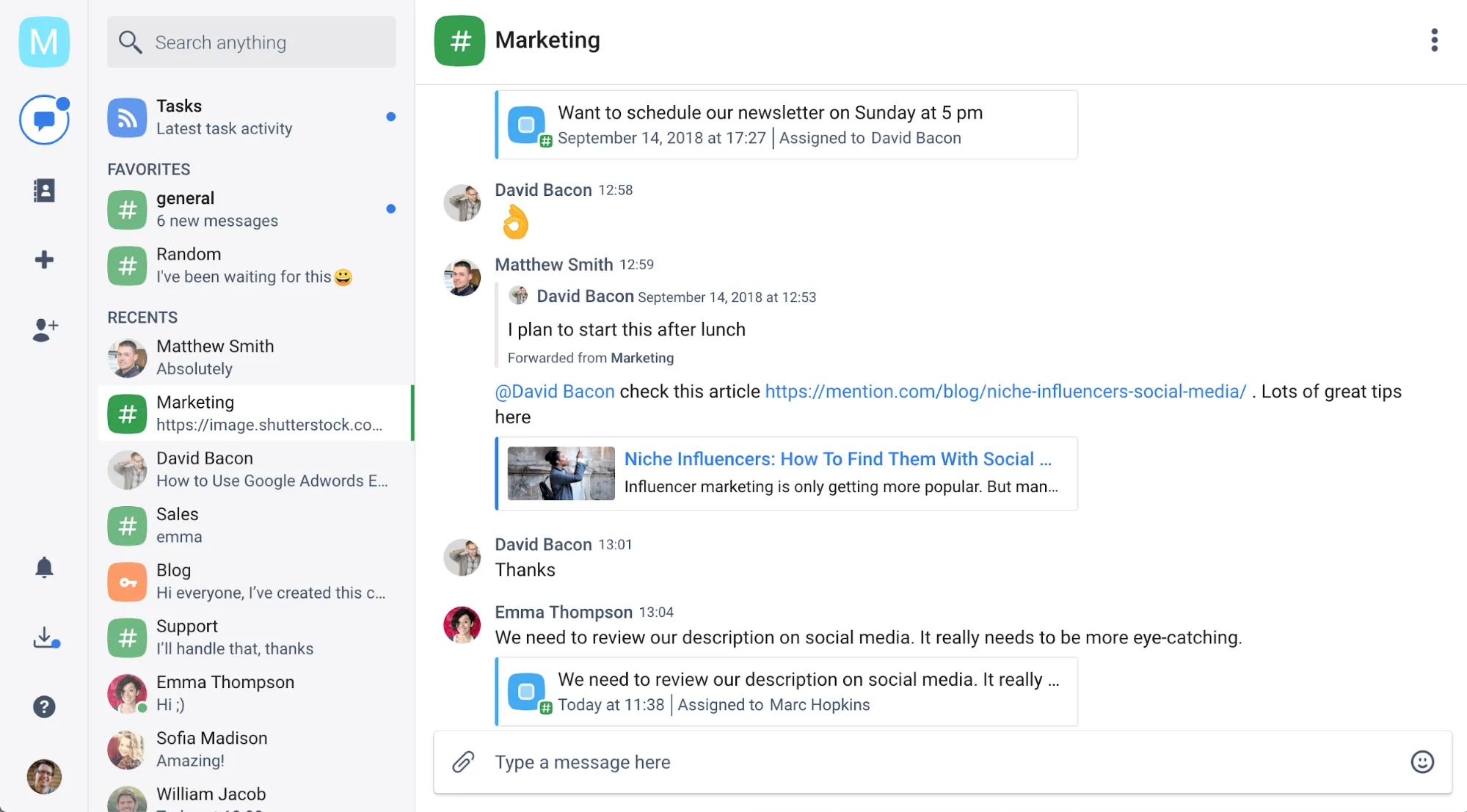Making the Remote Work Transition: Advice from Chanty & Problems They Faced
Blog: The Process Street Blog

This is a guest post from Julia Samoilenko, a marketing specialist who writes about digital marketing trends and strategies for the Chanty blog. This powerful and free Slack alternative is aimed to increase team productivity and improve communication at work. Feel free to connect with Julia on LinkedIn.
Many of us like the idea of working remotely (especially if we have never experienced it). Out of bed and —Voila!— you are ready for work. No commuting, no noisy colleagues. Top level of independence and flexibility.
But what is remote work really like in practice? One day here at Chanty we had to answer this question and discovered what new benefits and challenges teams face when transitioning to remote-only mode.
Spoiler: there were many productivity pitfalls on the road to beneficial collaboration. It turns out that being an efficient remote worker is quite challenging. And that it’s twice as tough to manage a high-performing virtual team.
If you want to adapt to remote working best practices and maximize the benefits, then you’ve come to the right place. We’re going to reveal the ugly truth and teach you everything we’ve learned about a successful transition to remote work. After reading our ‘confession’, you’ll understand the challenges and methods on how to overcome them.
In this Process Street article, we’ll be covering:
- How to successfully transition to remote work
- Our key takeaways for remote work transition
- Additional self-management and productivity resources
How to successfully transition to remote work
There is an ocean of large and small companies with remote employees. Because of the COVID-19 pandemic, this figure rose incredibly over the last few months. During especially dark days of our adaptation to the remote mode, we looked at the companies that had a successful transition to remote work to not give up.
For instance, Twitter went remote and covered everything from desks to printers that their employees needed during the home office setup, including video conferencing services and project management software. Facebook says that any employee who can do their work from home may continue to do so until year-end.
Google employees will probably continue to work remotely through the rest of this year. Zillow employees can work from home until the end of the year too.
Being in the same boat, we decided to keep up with our tech colleagues and developed our own strategy of a seamless transition to productive remote work.
Here it is!
Ensure everyone has needed tools under their belt
Team communication, productivity, and collaboration mainly start from home ‘office’ space. Investments in effective working space could increase productivity by up to 64 percent. Considering that, we ensured that every one of us had a perfectly organized workstation, from drawer organizers to desks and computers when transitioning to remote work.
Think about security
If your team members use their own laptop to connect to your system remotely, make sure that the devices they use are secure enough.
How? First, help your employees install endpoint protection software (basic antivirus software and firewalls).
Next, enforce password management: ensure that your teammates are using strong passwords for accessing your network and software platforms. If you want to share some account and login credentials, use a password manager application so the entire team can have access to specific websites.
What’s more, emails should be encrypted. Then, remote desktops should be accessed via a Virtual Private Network (VPN). So, provide the appropriate IT support to help teammates configure their devices and set up VPN services.
Employee training will help your remote workers learn how to protect themselves and your network. Educate your team on how to prevent cybersecurity threats. Also, create a response plan for the situations when the unexpected happens (a device with sensitive data is lost, unusual account activities are recognized, etc.) and clearly communicate it to your team. After that, they’ll know exactly how to act in different situations that involve IT security.
Overcome distractions while working from home
Are you complaining about office distractions? When your company transitions to remote work, you’ll be rudely surprised. Anyone who spent a single day working remotely can confirm that there are not fewer distractions at home than in an office. To tell the truth, various distractions were one of the biggest productivity killers that turned remote working for us into a nightmare.
If you live in a small apartment without a dedicated space to do your work, there will be a sea of distractions, from babies to laundry needing to be done. When you work where you live, be ready to separate these two worlds from each other.
How did we solve this issue? In a perfect world, a workspace should be a separate room dedicated to work and nothing else, where you come to get stuff done. But we discovered additional methods to make working from home more productive:
- Work on summer terraces in cafes. These places come with their own distractions, but they can be the better alternative to a home full of pets and relatives.
- Make sure that your family knows your working hours and ask them to respect your schedule (it probably won’t work out, but you can still try).
- Make an office out of a spare room: bedroom, storage room, balcony, garage, etc. A space that is just for you to get tasks done.
- Leverage your most unproductive hours. Think about how to utilize those hours where you might otherwise not be doing much of anything productive (the early morning hours, for instance). You’d be surprised what you could squeeze into a few hours each morning.
- Work at night. Sorry for this cruel advice, but it’s helped some of us.
Focus on productivity measurement and time management
Having transitioned to remote work, you don’t literally see how your employees use their working time. As a result, chances are you will want to take everything under constant control. It’s a productivity pitfall. Resist the urge to monitor your team strictly. Instead, feel free to steal some management hacks which have helped us to stay productive after remote work transition.
First, you can adopt a time tracker for personal use to understand how much time you have spent on certain tasks and identify what destroys your productivity. These apps can help you be more aware of where your time is going. Do you fall down a YouTube hole twice a day? Do you spend too much time answering unnecessary emails? These insights will help you adjust your working day accordingly and increase your productivity.
Second, find what actually you want to measure, your weekly or monthly key performance indicators (KPI). This north star helps you discover how well you’ve been doing over the past period. With the help of KPIs, you can track both long-term performance and short-term productivity. Also, roadmaps help remote teams stay on the right track.
Don’t forget to take care of your mental health

Let’s face it, despite having more free time to take care of health while working remotely, remote workers usually suffer from different mental and emotional issues. That’s the hidden and dangerous element of remote work transition.
The first issue is burnout and exhaustion. People are just tired, lose energy and joy. To avoid that, achieve work-life balance through unplugging after work. Switch off after the day and get a genuine break. The best way to switch off after work is to set achievable goals for each day and routinely hit those targets.
Second, pay attention to remote employee social isolation. Here at Chanty, we noticed that we started feeling a bit lonely and unengaged when we couldn’t grab a cup of coffee with colleagues before work or have a beer after.
Therefore, we took some proactive steps towards supporting our relationships after remote work transition:
- We start our virtual meetings by telling everyone something personal: how we are, what we are feeling, etc, what our news is, etc.
- We use a Chanty conversation channel for sharing non-work-related content, jokes, GIFs, and everything in between.
- We do something as simple as saying ‘Hey!’ every morning in the team chat.
Obviously, team spirit and mental health habits won’t materialize overnight. Thus, don’t strive for immediate results. Enjoy the process instead.
Adopt new tools for your remote work transition
Chanty relies on different tools to support the working process, especially when it comes to remote cooperation. On the other hand, having transitioned to remote work, we’ve already understood that more tools are not equal to more productivity and engagement. Every team needs to find the right balance between the number of tools and the challenges they face.
Where to start when choosing the go-to tool stack for your company transitioning to remote work? First of all, team chats are irreplaceable due to their robust features that optimize every nook and cranny of the workflow. Today team chats are much more than just a messenger tool.
Chanty

Yes, surprisingly enough, here at Chanty we use Chanty.
Why is it worth a try? Chanty is very secure, intuitive, and easy-to-use: your team won’t waste weeks to adopt this tool. Also, it provides unlimited message history, simple file sharing via attachments and drag & drop interface, powerful search, task manager, integrations, voice, and video calls – everything is for free.
To achieve a whole new level of productivity, we’ve integrated Chanty with Zapier. That allows us to:
- Get updated with recent events created on Google Calendar in any Public or Private conversation.
- Receive recent emails from Gmail directly in Chanty.
- Celebrate acquiring new subscribers on MailChimp.
- Catch the latest responses from Google Forms.
- Keep track of new records to Google Sheets.
- Keep up with new commits on your Git version-control system.
- Stay updated about new tasks, issues, or cards in your task manager.
- Never miss your new Salesforce or HubSpot leads.
- Monitor your sales activity on Stripe.
Process Street
Before jumping into Process Street, check out this quick introduction video to get an idea of what it’s all about:
One way to make sure you’re staying on track and minimizing distractions is by using checklists. And no, I don’t mean jotting down a to-do list on a piece of paper only to be misplaced and forgotten about.
Process Street is a BPM software that offers dynamic and practical superpowered checklists. They utilize features like Stop Tasks, Dynamic Due Dates, and Approvals to make sure you’re getting work done effectively and efficiently, never missing any deadlines.
For example, here’s Process Street’s Achieving Work-Life Balance Checklist below:
Brilliant, isn’t it?
If your company and projects are big enough, you will definitely need a solution to keep projects, tasks, resources, and documents under one roof. With tools like Asana or Wrike, your remote teammates can also access all needed information and files from anywhere, anytime.
Establish remote communication and collaboration rules
These ground rules establish clarity in digital communication and help remote employees stay connected and engaged after remote work transition.
Here’s a list of rules for you to consider:
- Create tags for important messages. For instance, #3HR can mark messages that require a reply within three hours after being sent.
- Sometimes it’s more productive to stop bombarding your colleagues with endless messages and jump on a two-minute call. So, use built-in call features or third-party video conferencing tools like Zoom.
- Speaking of endless messages, always strive for being understood using the bare minimum of words. At the same time, don’t confuse brief communication with clear communication when trying to be efficient. The balance lies somewhere in between.
- Make sure that teammates know your status (when you are available or away).
- Have regular video team meetings, but audio works, too.
- Share and synchronize your schedule with teammates, especially when collaborating across different time zones. That lets your team know when you are available for collaboration and protects your private life.
- Hold a meaningful meeting. Make sure that all participants know what is being discussed and that there’s a strict time limit. Always invite as few team members as possible and only the relevant ones. End a meeting with a straightforward result.
Pay attention to new employee onboarding
Since you can’t bring new remote workers to the office for their first days in the company if your company works remotely. Considering that, spend a couple of days with each new hire on various video chats to walk them through the daily processes and their role.
Also, provide new employees with all necessary hardware, furniture, tools, instructions, etc. Then assign a person who will be a virtual mentor for a new worker. Having a helpful buddy that guides a newbie through all the things they should learn, is really handy.
Our key takeaways for remote work transition
Organizing teams should not be a nightmare when transitioning to remote work. Remote work can be just as productive as an in-house one. To win this battle and make remote working work for you, use some tried-and-tested productivity tips that we’ve outlined:
- Make sure that everyone has a perfectly organized workstation.
- Think about security and utilize basic antivirus software, firewalls, VPN, and password management tools.
- Eliminate home distraction.
- Measure your productivity and work time: adopt a time tracker if needed, find your key performance indicators, create a roadmap.
- Take care of your mental health to prevent burnout.
- Adopt essential services that foster remote work: a team chat and project management tool.
- Establish remote communication rules.
- Pay attention to new employee onboarding.
To sum up, remote working brings a lot of benefits. In this article, we’ve listed a few tips on how to achieve a desired level of productivity and a work-life balance after remote work transition. Now, good luck on your road to a truly productive remote work!
Additional self-management and productivity resources
For more information on self-management and working remote, check out the resources below:
- 22 Self-Care Plan Checklists & Printables for a Happier & More Productive You
- Coronavirus Workplace Processes: 8 Checklists From Top World Health Expertsv
- How to Be Productive: Use a Powerful Productivity Systemv
- EAP Program: How to Keep Employees Safe, Secure, and Stable (Free Templates)
- 42 Productivity Hacks to Work Harder, Better, Faster, Stronger
- 8 Simple Steps to Get More Out of your Time
- Working From Home: Staying Productive in Troubling Times (Free Templates)
- Employee Engagement: How to Get a Happy, Productive Team
- Employee Assistance Program: How To Treat Your Team With Humanity
- 60+ Essential HR Processes for All Human Resource Teams (Free!)
- Don’t Micromanage: How It Destroys Your Team and How to Avoid It
- HR Best Practices: What They Are and How You Can Implement Them
- Burn out: How I Beat It, and How You Can Too
Did you struggle with any unexpected challenges when transitioning to remote work? How did you overcome them? Let us know in the comments below! We’d love to hear from you.

